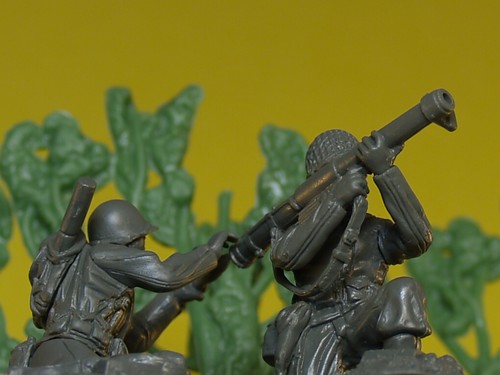Edward Uhl demonst rates the
army's new weapon in 1942
The Man Behind The Bazooka 2
World War II Magazine,  November/December 2010
November/December 2010
 November/December 2010
November/December 2010liant one at that. The tube was just long
enough so that the rocket would finish
its 1/50th-of-a-second burn by the time
it emerged from the front opening. The
whole thing weighed a mere 13 pounds
and could easily be carried in the field.
It took only two men to operate, one to
load the rocket into the back end of the
tube and hook up a wire that trailed out
of the rocket's tail, the other to aim and
fire by pulling a trigger that sent an
electric current to the igniter from a
battery in the stock of the launcher. It
could hit a tank or pillbox from 300
yards, putting a hole through four
inches of steel plate.

'I was walking by this
scrap pile, and there
was a tube that was
five feet long and 60
millimeters in
diameter...
I said, That's the
answer!'

Probably the real breakthrough for
Uhl and Skinner, though, came shortly
afterward. One day in May 1942 they
were firing some dummy rounds at a
moving tank at Aberdeen Proving
Ground in Maryland when Brigadier
General Gladeon Marcus Barnes, the
head of ordnance research and development,
happened to pass by with some
other visiting brass. Noticing all of the
flames and whooshes, they came over
to see what was going on. Skinner saw
his chance and—taking a certain
calculated risk—handed the launcher to
Barnes and offered to let him take a
shot.  Barnes nailed the tank on his first
Barnes nailed the tank on his first
 Barnes nailed the tank on his first
Barnes nailed the tank on his firsttry, and pretty soon the visitors had
fired off all of the available rounds.
The weapon was ordered into
production that day; in one of the
fastest development contracts in history,
General Electric was given 30 days to
deliver an initial 5,000 launchers—and
finished the order with 89 minutes to
spare.
By the end of the war, 440,000
bazookas had reached the field. (The
name came from a joke musical instrument
comedian Bob Burns has made
famous in his 1930s radio shows; made
of 3-inch gas pipe and sounding like a
"wounded moose," it bore a definite
resemblance to the rocket launcher.)

Uhl left the army as a lieutenant
colonel in 1947 and went on to become
chairman of the giant defense contractor
Fairchild Industries, but he never forgot
the lesson of what a small team of
innovative thinkers can do. "We have
gotten into the bad habit of heaping
people onto projects," he once said.
"The trap we've fallen into is to believe
that a thousand incompetents properly
organized can do the job of a few dozen
outstanding people."  EDWARD UHL was barely out of
EDWARD UHL was barely out ofcollege and barely into uniform when he
found himself constituting 50 percent of
the U.S. Army's rocket research
program. Along with another engineer,
a young major named Leslie Skinner,
Uhl was to figure out some way that
armor-piercing could hurl an armorpiercing
grenade at a target.

The grenades were extremely effective,
using a hollow explosive charge to
form a focused funnel of gas that cut
through armor like a blowtorch. But at
nearly four pounds, they weighed too
much to throw by hand or be fired from
the end of a rifle barrel. So far, the only
idea anyone had for delivering it was
for some poor sap to run up and stick it
directly on the surface of an oncoming
enemy tank.
The army had done a few experiments
with rocket-propelled projectiles as
early as the end of World War I. The
catch was finding some way to shield
the soldier who fired it from the jet of
flame and hot gases that spewed
directly back as the rocket took off. Uhl
was probably engaging in a little
hyperbolic hindsight when he told the
story years later of the eureka moment
he had one day in the spring of 1942
that solved the problem: "I was walking
by this scrap pile, and there was a tube
that was five feet long and 60
millimeters in diameter, which
happened to be the same size as the
grenade that we were turning into a
rocket. I said, 'That's the answer! Put
I said, 'That's the answer! Put
 I said, 'That's the answer! Put
I said, 'That's the answer! Putthe tube on a soldier's shoulder with the
rocket inside, and away it goes."
But it was no exaggeration that the
firing tube was the solution, and a bril-
No comments:
Post a Comment